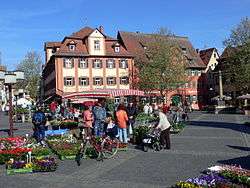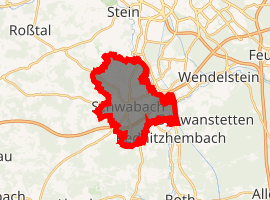Schwabach
Schwabach (German pronunciation: [ˈʃvaːbax]) is a German town of about 40,000 inhabitants near Nuremberg in the centre of the region of Franconia in the north of Bavaria. The city is an autonomous administrative district (kreisfreie Stadt). Schwabach is also the name of the river which runs through the city prior to joining the Rednitz.
Schwabach | |
|---|---|
 Market square | |
 Coat of arms | |
Location of Schwabach 
| |
 Schwabach  Schwabach | |
| Coordinates: 49°19′45″N 11°1′15″E | |
| Country | Germany |
| State | Bavaria |
| Admin. region | Mittelfranken |
| District | Urban district |
| Government | |
| • Lord Mayor | Matthias Thürauf (CSU) |
| Area | |
| • Total | 40.71 km2 (15.72 sq mi) |
| Elevation | 326 m (1,070 ft) |
| Population (2018-12-31)[1] | |
| • Total | 40,792 |
| • Density | 1,000/km2 (2,600/sq mi) |
| Time zone | CET/CEST (UTC+1/+2) |
| Postal codes | 91101–91126 |
| Dialling codes | 09122, 0911 |
| Vehicle registration | SC |
| Website | www.schwabach.de |
Schwabach is famous for its crafts made of gold, particularly gold foil. In 2004, Schwabach celebrated this tradition with an anniversary festival, marking "500 years gold foil in Schwabach".
Around 1500, a local typesetter developed the "Schwabacher" font. This font was used for printing the first Bible in German, which had been worked out by Martin Luther.
Schwabach is also the birthplace of composer Adolf von Henselt, the botanist Johann Gottfried Zinn, the biologist Ralf Baumeister and one of the developers of MP3, Bernhard Grill. It was often visited by Albrecht Dürer.
Etymology
The name derives from the old Franconian name Suapaha (later Suabaha, then Villa Suabach) which translates as "Schwaben-Bach" in modern German, which means "Swabian stream", the first part of the name was given by the Franconians who came to the area about a millennium after the Hallstatt culture to the people living on the banks of that stream, which were perceived as "Swabians" by them, while the second part of the name is a reference to the stream which flows through town.
Timeline

- 750 BC–AD 500: Archaeological evidence of settlement.
- 600–700: Name Schwabach first used to refer to the settlement and the river.
- 1346: City wall built.
- 1371: Municipal law established.
- 1469: Town church built (still in use).
- 1500: (ca.) Schwabacher font invented.
- 1528: City hall built (still in use).
- 1633: First needle factory established in Schwabach.
- 1723: Schwabach river flooded to highest point ever. Markings of the flood are still visible.
- 1768: The landmark Old Linden Tree planted (still there).
- 1792: Schwabach became part of Prussia.
- 1797: Goethe stayed overnight in Schwabach.
- 1806: Schwabach became part of Bavaria.
- 1849: Railway station built.
- 1941: Schwabach bombed in World War II
- 1945: American military base established in Schwabach.
- 1953: City coat-of-arms introduced.
- 1972: Schwabach became an autonomous administrative district.
- 1975: Partner-city relationship with Les Sables d'Olonne established.
- 1980: Schwabach receives the European Union prize for cultural heritage.
- 1992: US Army to be withdrawn from Schwabach and surrounding areas.
- 2004: 500-year anniversary celebration of the gold foil industry.
Notable people
Politicians
- Hans Schuberth (born April 5, 1897, died September 2, 1976 in Munich), politician (CSU), Federal Minister for affairs of telecommunication
- Karl Freller (born March 2, 1956), Member of the Bavarian Parliament (CSU)
Athletes
- Matthias Volz (born 4 May 1910 in Schwabach; died 26 August 2004 in Spalt), Turner, artistic gymnast Olympic champion (team) and bronze medalist in Berlin in 1936, TV 1848 Schwabach
- Manfred Ritschel (born June 7, 1946), football player
Scientists
- Bernhard Grill (born January 5, 1961), involved in the development of mp3 - format
Artists
- Walter Zimmermann (born April 15, 1949), composer
Twin towns - sister cities
Schwabach is twinned with:[2]



Companies
- Apollo-Optik, optics company
References
- "Fortschreibung des Bevölkerungsstandes". Bayerisches Landesamt für Statistik und Datenverarbeitung (in German). July 2019.
- "Partnerstädte". schwabach.de (in German). Schwabach. Retrieved 2019-11-28.
External links
| Wikimedia Commons has media related to Schwabach. |
- . Encyclopædia Britannica (11th ed.). 1911.